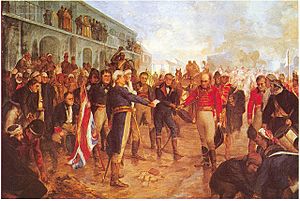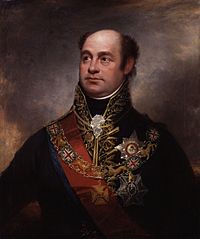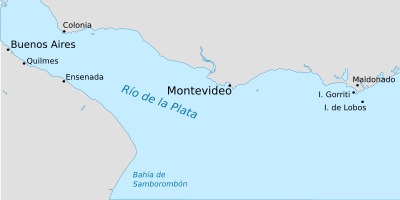British invasions of the River Plate facts for kids
Quick facts for kids British invasions of the River Plate |
|||||||
|---|---|---|---|---|---|---|---|
| Part of Anglo-Spanish War (1796–1808) | |||||||
 William Beresford surrenders to Santiago de Liniers (1806) |
|||||||
|
|||||||
| Belligerents | |||||||
| Commanders and leaders | |||||||
| Rafael de Sobremonte Santiago de Liniers Juan Martín de Pueyrredón Martín de Álzaga |
Home Riggs Popham William Beresford (POW) John Whitelocke |
||||||
| Strength | |||||||
|
First invasion:
Second invasion:
|
First invasion:
Second invasion:
|
||||||
| Casualties and losses | |||||||
| First invasion: 205 dead and wounded Second invasion (Montevideo): 1,500 casualties Second invasion (Buenos Aires): 600 killed and wounded |
First invasion: 157 dead and wounded, 1,300 captured Second invasion (Montevideo): 600 casualties Second invasion (Buenos Aires): 311 killed, 208 missing, 679 wounded, 1,600 captured |
||||||
The British invasions of the River Plate were two times when the British tried to take control of parts of the Spanish colony called the Viceroyalty of the Río de la Plata. This area is now Argentina and Uruguay. These events happened between 1806 and 1807. At this time, Spain was helping Napoleonic France during the Napoleonic Wars. In Argentina, these two defeats of the British are known as the "Reconquista." This means "reconquest" and shows how the local people fought back and won.
Contents
What Happened During the Invasions?
The invasions happened in two main parts. First, a British army group took over Buenos Aires in 1806. They stayed for 46 days before the local people forced them out.
In 1807, a second British force attacked and took Montevideo. They stayed there for several months. Then, a third British group tried to take Buenos Aires again. After many days of street fighting against local fighters and the Spanish army, the British lost. About half of their soldiers were killed or hurt. They had to give up and leave Montevideo two months later.
These invasions had a big impact on the people living there. They helped lead to the May Revolution. Before this, local people, called criollos, didn't have much power. But by fighting the British, they gained military strength. They saw that they could defend themselves with little help from Spain. This made them want to rule themselves. An open cabildo (a special meeting) and the Royal Audiencia of Buenos Aires even removed the viceroy, Rafael de Sobremonte. This was a huge step, as a viceroy was usually only answerable to the King of Spain.
Why Did the British Want the River Plate?
The British had wanted to control parts of South America for a long time. They thought the Río de la Plata area was the best place for a British colony. This was because it was a good spot for trade.
The Napoleonic Wars played a big role in these invasions. In 1796, Spain joined France in a war against the United Kingdom. This gave the British a reason to attack Spanish colonies. In 1805, after the Battle of Trafalgar, Spain's navy was very weak. This made it hard for Spain to send ships and help to its colonies in America. Buenos Aires had not received much help from Spain for many years.
British leaders like Home Riggs Popham believed that taking control of key places in South America would open new markets for British goods. They wanted to weaken Spain's power over its colonies.
The First Invasion (1806)

In 1805, British Admiral Popham was ordered to protect the Cape of Good Hope. But he decided to try and take the Río de la Plata instead. He learned that some people in Buenos Aires were unhappy with Spain's strict trade rules. Popham got about 1,000 soldiers from David Baird. He made William Carr Beresford the general in charge.
The Spanish Viceroy, Rafael de Sobremonte, had asked Spain for more soldiers many times. But he only got some muskets and instructions to form a local army. Buenos Aires had about 45,000 people. However, the Viceroy didn't want to give weapons to the local Creole people. Many of the best Spanish soldiers were away fighting a revolt in Upper Peru (now Bolivia). When Sobremonte heard the British were coming, he sent his remaining troops to Montevideo. He thought the British would attack that city. So, Buenos Aires was left almost without defense.
The British landed near Buenos Aires at Quilmes on June 25, 1806. They marched into Buenos Aires and took it over on June 27. The Viceroy ran away to Córdoba with the city's money. He lost the money to the British during his escape. Even though he followed a rule about keeping the treasury safe, people saw him as a coward.

At first, some wealthy families in Buenos Aires even welcomed the British. But many locals were against them. Manuel Belgrano, an important figure, said, "We want the old Master or none at all" before leaving the city. Some merchants were unhappy because the British ended Spain's trade rules, which hurt their businesses.
Juan Martín de Pueyrredón tried to form a local fighting group, but the British found and defeated them. Santiago de Liniers, a French officer working for Spain, saw what was happening. He went to Montevideo and got 550 experienced soldiers and 400 regular soldiers. He quickly returned to Buenos Aires.
On August 4, 1806, Liniers landed north of Buenos Aires. He marched towards the city with his mixed force. By August 10, he had taken important points. Beresford finally gave up on August 14. After this, a special meeting decided to remove Viceroy Sobremonte from military command. They gave this power to Liniers, who was seen as a hero. Sobremonte did not return to Buenos Aires.
People in Buenos Aires then formed local fighting groups, called militias. These included groups like the Patricios and Húsares. The Spanish leaders were worried that these local forces might want to break away from Spain. During this first invasion, the British 71st Regiment of Foot lost their flags. These flags are still kept in Argentina today.
The Second Invasion (1807)
Battle for Montevideo
On February 3, 1807, the British attacked Montevideo. About 5,000 defenders were in the city. The British had about 15,000 soldiers and a navy fleet. They needed to win quickly because more Spanish soldiers were coming from Buenos Aires.
The British broke through the city walls fast. Inside, they faced strong resistance. But they slowly pushed back the Spanish defenders. Another British attack from a different side helped them win. The Spanish Governor, Ruiz Huidobro, surrendered around 5:00 a.m. The Spanish had 600 people hurt and 2,000 taken prisoner. The British had 600 people hurt.
On May 10, Lieutenant-General John Whitelocke arrived in Montevideo. He took overall command of the British forces, which now had about 13,000 soldiers.
Second Battle for Buenos Aires
On July 1, the forces led by Liniers fought the British outside Buenos Aires. The British had more soldiers and won this first fight. At this point, Whitelocke did not enter the city right away. He asked the city to surrender twice.
Meanwhile, Buenos Aires' mayor, Martín de Álzaga, organized the city's defense. People helped dig trenches, strengthen buildings, and put up fences. The local people, especially the Creoles, really wanted independence. Three days later, Whitelocke decided to attack Buenos Aires. He divided his army into 12 groups and marched in without cannons to protect them.
His army was met in the streets by a mixed group of fighters. This included 686 African slaves, along with local soldiers. Fighting continued on July 4 and 5. Whitelocke did not understand how hard street fighting would be. People threw cooking pots filled with hot oil and boiling water from rooftops, hurting many British soldiers. The locals eventually defeated the British troops. The British suffered 1,000 people hurt.
By the end of July 5, the British controlled some areas but not the city center. Their soldiers were losing hope. Local fighters and colonial troops then launched a counter-attack. They defeated many important British commanders. Whitelocke offered a 24-hour break in fighting, but Liniers refused and ordered more attacks.
After losing 311 killed, 679 wounded, and 1,808 captured or missing, Whitelocke signed a peace agreement with Liniers on August 12. The local fighters played a big part in defeating the British. Many British soldiers left their units after the defeat. More than 50 were sent back to Britain and faced trial. Others were allowed to stay and later helped free Chile.
Whitelocke left the Río de la Plata area, taking British forces from Buenos Aires, Montevideo, and Colonia. He left behind 400 seriously wounded soldiers. When he returned to the United Kingdom, he was put on trial and removed from his position. This was mainly for giving up Montevideo. Newspapers in Britain strongly criticized him for surrendering to mostly local fighters. Liniers was later made the new Viceroy of the Río de la Plata by the King of Spain.
Today, August 12 is known in Argentina as the day of the "Reconquista de Buenos Aires," celebrating the victory.
Towards Independence
The British invasions showed the people of the Río de la Plata that they could defend themselves. Spain had been busy with the Napoleonic Wars and offered little direct help. This made the idea of independence grow stronger. Local fighting groups were led by future revolutionary leaders like Cornelio Saavedra and Manuel Belgrano. This also helped spread the desire for self-rule.
In 1808, Napoleon put his brother, Joseph Bonaparte, on the throne of Spain. This created a chance for the May Revolution to happen in 1810. This revolution was a big step towards Argentina's Declaration of Independence of Argentina in 1816.
See Also
Images for kids




